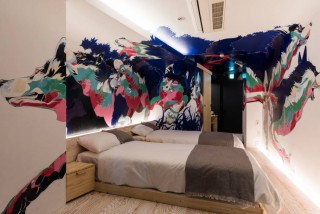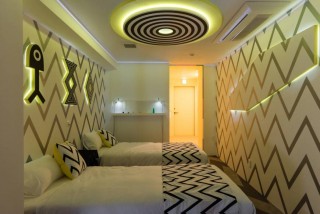Loading
Search
▼ Tokyo Hotel Gets Into Bed With Local Artists
- Category:Stay
When building a new hotel, designers would normally consider the artwork displayed on the walls as a finishing touch. But for BnA Hotel Koenji, which just opened in Tokyo’s Koenji neighborhood, the artwork definitely comes first.
BnA Hotel Koenji, produced by the Bed & Art Project, is the third live-in-art-experience designed by a group of young Tokyo-based entrepreneurs who were looking for ways to shine a spotlight on the vast pool of artistic talent in Japan. It was a discussion about the rapidly growing Airbnb movement that sparked an idea to do something a little more grass roots and connected to the community.
“In 2013, Taz (Yu Tazawa) and I were discussing the social-political issues surrounding gentrification and rising rent prices in Silicon Valley caused by the tech bubble,” explains interior designer and BnA team member Keigo Fukugaki. “Our conversation got heated when we started talking about Airbnb and how it was becoming another vehicle of gentrification and exploitation. Through that conversation, we got the idea of leveraging the hospitality industry to do social good by supporting artists while offering a truly inspiring experience.”
That same year Fukugaki, Taz and fellow creative entrepreneur Yuto Maeda began work on Bed & Art Project very first rooms in Ikebukuro, a cooperative initiative that employed local artists to go beyond simply making artwork to hang on the walls. Instead the artists were invited to work together with designers to create entire rooms as immersive art experiences. The following year they built BnA Kyoto, which was also an instant hit both with locals and foreign travelers. The wild success of these two initial projects acted as the impetus for a much more comprehensive project — the BnA Hotel Koenji.
As a first step in March of this year, they opened a central building that features a cafe/bar, gallery, rooftop terrace and two art-hotel rooms. But Fukugaki, Taz and crew have bigger plans for Koenji, and they are already looking to acquire additional properties so that they can build art-hotel rooms all around this creative hub. In this model, the central building would eventually act as a collective front desk where guests could check in before being led to one of several satellite buildings in the same area.
The BnA team has also reached out to local businesses so they can offer its guests options such as breakfast and bike rentals as part of a package deal. An “artist in residence” program, which will provide free accommodations and a space to work for selected artists on a periodic short-term basis, ensures there will always be art being created and exhibited on site. This unique local artistic ecosystem means that anyone who checks into BnA is immediately connected to an extended community in Koenji and can enjoy a creative cultural experience unthinkable with traditional accommodations.
“We try to work with local artists with strong connections to the neighborhood,” explains Taz. “Especially for the Koenji project, one of our main goals is to connect travelers to the local creative community, so it was essential that the artists that we work with for the initial rooms are deeply rooted to the scene. It was also important for us to pick two artists with a big contrast in style, in order to showcase the depth and the potential of the project with just two rooms.”
One of those artists, Yohei Takahashi, was amazed at both the creative control he was given in designing the room, and the potential the project has to bring the eyes of the world on his artwork.
“I don’t think there has ever been a hotel like this,” says Takahashi. “I wasn’t just asked to make art for a hotel room. I was asked to make a hotel room into art, and that was an amazing experience. Even while I was working, there were so many people from all walks of life in and out of that room, I knew this project was going to be a hit.”
Takahashi’s room, which features his signature animal paintings, reveals multiple layers of boldly colored wolves that watch over guests as they sleep. In contrast, the second art room designed by Ryuichi Ogino uses bold black and white lines and neon lighting for a more contemporary experience.
It is important to note that the artists involved in BnA receive a share of the profits for each hotel booking, making them essentially vested partners in the project. In a country like Japan, which doesn’t have a well-developed art market, this kind of income can be pivotal to artists for them to be able to continue their work.
What’s next for these pioneering creatives?
“We plan to build 30 to 40 rooms in Koenji within the next four years, each offering a unique experience and new works by up-and-coming artists,” says Fukugaki without hesitation. “And eventually we want to take this concept around the world.”
One of those artists, Yohei Takahashi, was amazed at both the creative control he was given in designing the room, and the potential the project has to bring the eyes of the world on his artwork.
“I don’t think there has ever been a hotel like this,” says Takahashi. “I wasn’t just asked to make art for a hotel room. I was asked to make a hotel room into art, and that was an amazing experience. Even while I was working, there were so many people from all walks of life in and out of that room, I knew this project was going to be a hit.”
Takahashi’s room, which features his signature animal paintings, reveals multiple layers of boldly colored wolves that watch over guests as they sleep. In contrast, the second art room designed by Ryuichi Ogino uses bold black and white lines and neon lighting for a more contemporary experience.
It is important to note that the artists involved in BnA receive a share of the profits for each hotel booking, making them essentially vested partners in the project. In a country like Japan, which doesn’t have a well-developed art market, this kind of income can be pivotal to artists for them to be able to continue their work.
What’s next for these pioneering creatives?
“We plan to build 30 to 40 rooms in Koenji within the next four years, each offering a unique experience and new works by up-and-coming artists,” says Fukugaki without hesitation. “And eventually we want to take this concept around the world.”
- April 25, 2016
- Comment (0)
- Trackback(0)



